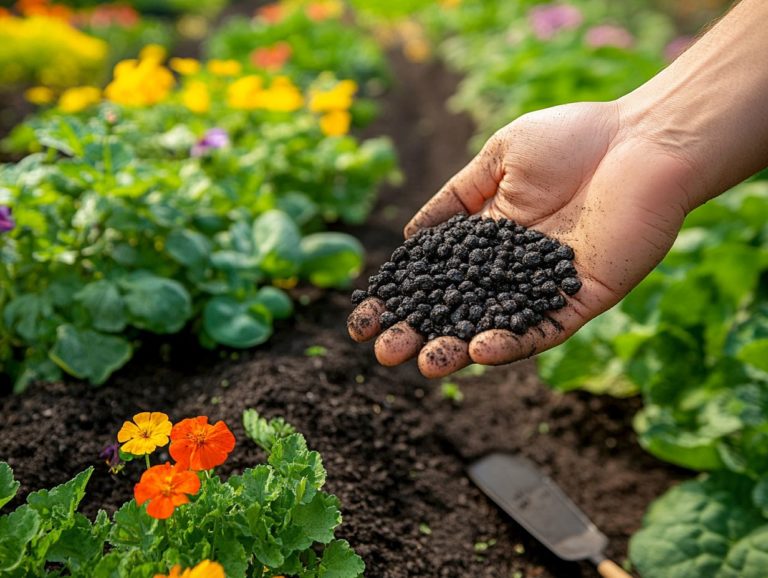What is the Role of Microclimates in Gardening?
Microclimates are essential to the art of gardening, providing distinctive opportunities to elevate plant growth and health. By understanding what microclimates are and the factors that influence them, you can leverage their benefits to enrich your green spaces and recognize the various conditions that affect your garden.
This exploration will guide you through how microclimates can invigorate your plants. You will learn techniques for identifying them in your garden and strategies to maximize their potential, including tips for managing soil and water.
You will discover practical methods to create and manipulate microclimates, ensuring your garden flourishes under any conditions. Embrace this journey to unlock the full potential of your garden!
Contents
Key Takeaways:

- Microclimates are localized climate conditions within a larger area. They can be influenced by factors like topography and vegetation, and have a significant impact on plant growth in a garden.
- Microclimates provide benefits to gardening, such as creating optimal conditions for specific plants or extending the growing season. Understanding and identifying microclimates in your garden can help you make the most of your gardening space.
- There are various methods for identifying microclimates, such as observing temperature and moisture levels and using tools like thermometers and hygrometers. Once identified, you can use strategies like windbreaks and mulching to manipulate microclimates to your advantage.
Understanding Microclimates
Unlocking the secrets of microclimates can transform your gardening game! These localized atmospheric conditions can vary significantly from the surrounding areas, affecting temperature and humidity levels. Factors such as temperature, humidity, and soil composition play a vital role in creating these unique environments, influenced by nearby trees, hedges, and structures.
The Royal Horticultural Society emphasizes their importance. By making the most of these conditions, you can optimize plant growth, enhance vegetation diversity, and tackle gardening challenges especially in regions with diverse climates like the USA and Australia, including subtropical climates.
By assessing microclimates, you can tailor your garden design to meet specific growing needs, resulting in healthier plants and improved yields while understanding the role of nearby structures and trees.
Definition and Factors that Influence
A microclimate refers to a specific, localized area where climate conditions diverge from those of the surrounding environment. It is often shaped by factors like topography, which is the arrangement of the natural and artificial physical features of an area, sunlight exposure, and the presence of structures or vegetation, as well as the local climate.
For example, when you find yourself under the canopy of large trees, you’ll notice a significant drop in temperature compared to sunlit patches this creates a haven for delicate plant species and various forms of wildlife. Similarly, hilly terrain introduces a fascinating dynamic, as slopes can either trap or release heat differently throughout the day.
Humidity levels can shift dramatically, influencing not just plant life but the overall biodiversity as well, impacting the growth patterns of various plants.
In urban environments, buildings contribute to these microclimates by casting shadows and creating wind tunnels, further complicating the climate equation. Grasping these dynamics is essential for anyone looking to implement effective environmental management and landscaping strategies.
Benefits of Microclimates in Gardening
The benefits of microclimates in gardening are abundant. They offer tailored conditions that enhance plant growth, safeguard against extreme weather, and optimize resource management.
By creating sheltered environments, you can effectively mitigate drought stress, lessen the impact of frost, and elevate overall plant health. For instance, with the strategic placement of structures, trees, and hedges, you can promote better water retention and soil drainage while enhancing the overall conditions for your garden.
By grasping the advantages of microclimates, you can transform an ordinary garden into a thriving ecosystem, fostering diverse plant species and robust growth patterns.
Get ready to see your garden thrive! Share your experiences or ask questions about microclimates below!
How Microclimates Can Improve Plant Growth

Microclimates can elevate your gardening by creating ideal conditions for your plants. By harnessing these unique environments, you achieve better temperature regulation, moisture retention, and light exposure.
Understanding these localized conditions is key to enhancing your gardening success. For example, positioning denser foliage or taller plants can provide shade for delicate flowers, extending their blooming period.
You can control humidity levels by adding windbreaks or water features that increase moisture in the air around your plants.
Certain soil conditions can enhance drainage and nutrient availability, which is critical for healthy roots. To maximize these advantages, consider adding mulch to maintain soil temperature and moisture.
Pay attention to specific spots in your garden that flourish. They can provide valuable insights into optimizing your gardening strategy.
Identifying Microclimates in Your Garden
Identifying microclimates in your garden requires a thoughtful examination of the natural features that shape local growing conditions, including sun exposure, wind patterns, and existing vegetation. By observing these elements, you can uncover the unique microclimates present in your space, enabling you to optimize plant placement and care.
Utilizing tools such as thermometers and soil moisture sensors will enhance your identification process. Moreover, paying attention to nearby structures and trees can reveal potential shelter and shade opportunities.
Methods for Identifying Microclimates
Discover several exciting methods to identify microclimates in your garden, including observational assessments, temperature readings, and soil moisture analysis.
One practical approach is to map your garden, pinpointing areas of sun and shade that impact plant growth and health. This involves observing how sunlight shifts throughout the day and noting which zones stay cooler or warm.
Monitoring temperature fluctuations with a simple thermometer can offer valuable insights into heat retention across different sections of your garden. Equally important is evaluating soil conditions. By checking moisture levels, you can determine which areas may need extra irrigation or amendments to enhance plant performance.
By incorporating these methods into your gardening practices, you can tailor your strategies to suit the unique environment of your outdoor space.
Using Microclimates to Your Advantage
Using microclimates means employing smart gardening practices that boost plant health and make the most of your garden’s unique resources.
Strategies for Maximizing Microclimates in Gardening

Maximizing the benefits of microclimates in your gardening endeavors requires thoughtful strategies that consider the unique conditions present in various areas of your garden.
By closely observing sun patterns, moisture levels, and wind directions, you can tailor your approach to suit different sections perfectly, ensuring optimal exposure for your plants. For instance, consider planting shade-tolerant species like ferns or hostas in areas shielded from direct sunlight; this will ensure they flourish even in less-than-ideal lighting.
Implementing windbreaks, such as rows of tall grasses or shrubs, not only minimizes harsh winds but also cultivates a calmer environment, enhancing the microclimate for more delicate plants and providing necessary shelter. Adding water features like ponds or fountains can elevate humidity levels, promoting a balanced ecosystem that benefits both flora and fauna.
By combining these strategies, you can create thriving, diverse habitats that truly harness the distinctive qualities of your landscape.
Start implementing these strategies today and watch your garden thrive like never before!
Creating Microclimates in Your Garden
Creating microclimates in your garden can significantly enhance plant growth. By thoughtfully adjusting temperature and moisture levels through strategic design and planting, you cultivate a more diverse and productive environment that optimizes the growing season for your plants.
Embrace this approach to elevate your gardening experience and enjoy flourishing plants. Take full advantage of the unique features of your garden’s microclimates!
How to Adjust Temperature and Moisture Levels
Adjusting temperature and moisture levels is crucial for creating effective microclimates that meet the specific needs of your garden s plants, especially in regions prone to drought. By considering how these elements interact, you can significantly enhance both plant health and productivity.
Using mulch retains moisture and suppresses weeds that compete for valuable resources. Providing shade to your plants during peak sunlight hours protects them from heat stress and fosters better growth and flowering.
If you re ready to elevate your gardening game, consider utilizing greenhouses for precise climate control. This allows you to cultivate a broader variety of plants throughout the year. Implementing these techniques can create a vibrant and thriving garden tailored to your environmental conditions.
Frequently Asked Questions
What is the Role of Microclimates in Gardening?

The role of microclimates in gardening is to create diverse and unique growing conditions for different types of plants. This allows for a wider range of plants to thrive in a specific area, as each microclimate provides different levels of sunlight, moisture, and temperature. For example, certain trees and shrubs might flourish in these conditions, contributing to the seasonal beauty of a garden.
How do Microclimates Impact Plant Growth?
Microclimates can significantly impact plant growth. The varying levels of sunlight, moisture, and temperature can affect how well a plant thrives in a specific area. Some plants may require more or less sunlight, while others may need a specific level of moisture to flourish.
Can Microclimates Help Extend the Growing Season?
Yes! Microclimates can help extend the growing season for certain plants. In areas with cooler temperatures, a microclimate can provide a warmer and more sheltered environment for plants to continue growing. This is especially beneficial for growing plants that are not native to the region.
Start creating your garden’s microclimates today and watch your plants thrive!
How Can Gardeners Create Microclimates?
Gardeners can create microclimates by placing plants in different areas of their gardens. For instance, put sun-loving plants in sunny spots and shade-loving ones in shadier areas.
Using structures like trellises or fences can block wind and create sheltered spaces. Containers allow for flexibility in plant placement, especially for early flowering varieties.
What are Some Tips for Maintaining Microclimates?
Maintaining microclimates requires regular observation. Gardeners should check sunlight, moisture, and temperature levels and make adjustments as needed.
This might include adding mulch, changing watering schedules, or providing temporary shade. Keeping these areas healthy means happier plants!
What are the Benefits of Using Microclimates in Gardening?
Microclimates offer many benefits. They allow for a wider variety of plants, extend the growing season, and boost plant growth and yield.
These techniques add diversity and interest to gardens. For instance, gardeners in the USA and Australia use methods promoted by the Royal Horticultural Society to unlock their gardens’ full potential.






